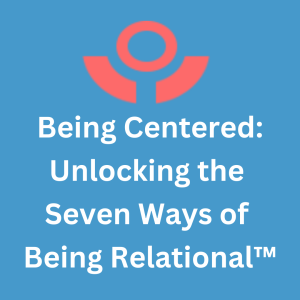
What is Being Centered?
Last month, we introduced the concept of Being Centered–a fundamental element to The Relational Approach ©, pioneered by Louise and Bill Senft through their mediation work over the past 30 years at Baltimore Mediation. As a reminder, the Relational Mindset focuses on interactions that are natural and authentically oriented to connection with others, which empower and bring joy to you and others. We talked about what it feels like to be centered, when you’re in harmony with others and within yourself. When you are centered, your heart is calm, peaceful, strong, wise and expansive. You are in tune with your body and your breath, and use this awareness as a guide back to center when in the heightened state of conflict. For example, if a mother is screaming at her kids behind you at the grocery store, you let the oxygen fill you with empathy and offer an act of kindness rather than judgment.Being Centered is Counter-Egoic
Being Centered is counter to our human defense mechanisms. And it is not what our society values; we are not taught breathwork in schools for instance (where it might be the most helpful!). It’s also counter to what our origin brain tells us to do when we are in conflict, which is to clamp down on prefrontal oxygen flow. To counter this, we must breathe deeply. If your body is unsettled, Being Centered means noticing and accepting the sensation, rather than trying to fight it or ignore it. If you honor and befriend the emotional imbalance through your breath, you are likely to find its energy released when you exhale, protecting your body from the long-term health impact of pushing the energy down inside.Being Centered is Being Alert to Triangling
In addition to finding the center within yourself, Being Centered calls you to find and stay centered in your relationship to others. Losing your centeredness in relationship to others typically happens when someone comes to you with a complaint, gripe, or piece of gossip about someone else. If you’re not centered, you may respond abruptly with agreement or saying nothing, thus escalating conflict and division. For example, if your colleague tells you that your boss expects all the projections for next year’s budget by Monday, you might react immediately with, “Oh my God, that jerk!” or “Oh, great (sarcastically). There goes my weekend.” Triangling is when you become part of someone else’s conflict without even realizing it. You are not Being Centered. To avoid triangling, and the consequential fractures and harm to group dynamics, start by being complaint-free. This does not mean you put up with things that are bothering you, grin and bear it. You express your views, engage in dialogue, listen deeply to others, and become more knowledgeable about the consequences associated with the change you seek. If you have a problem that someone else can address, then you take it to them directly, and only them. This way, you avoid becoming the person who starts a wave of destructive triangling.Being Centered is Choosing Unitive Triangling
Now that you know how to avoid starting destructive triangling, let’s look at how to stop it when it’s happening. First, pause and listen deeply and fully before responding. Take a belly breath. Suspend judgment. Offer a reflection–part of Being Engaged. Ask an open-ended question. Now that you’re not immediately joining in, they have space to dig deep into the core of what’s bothering them, often rooted in fear. Being Centered allows you to be responsive, not reactive, and allows them to think more clearly and thoughtfully about their situation. This is unitive triangling, a way of relating to the others involved that restores the quality of the interaction itself, a way that fosters personal strength and openness to the other person as a first option, which will increase well-being for all (including yourself).Important learning: When you engage from a place of center, you can expect restoration of your own personal strength and a more steady sense of yourself when confronted with future conflicted situations.
Try it at home: When faced with triangling situations, which are everywhere, try remaining centered and choosing unitive triangling as the first option. Rather than jumping in to align with them, or dismiss or correct them, try offering a reflection and assisting the complainer with making a request or having a conversation.
In Being Relational™, the first Four Ways of Being Relational–Being Engaged, Being Centered, Being Grounded and Being Clear–lead to quality dialogue and tend not to escalate conflict in an unhealthy way and are based in the relational theory of conflict on which Baltimore Mediation has based its work.
Being Centered is being aware of your reactions and getting into the “flow” with your mind, body and heart. Next month in the Gazette, you can look forward to an introduction to Being Grounded. Learn more about this worldview in our book, Being Relational.